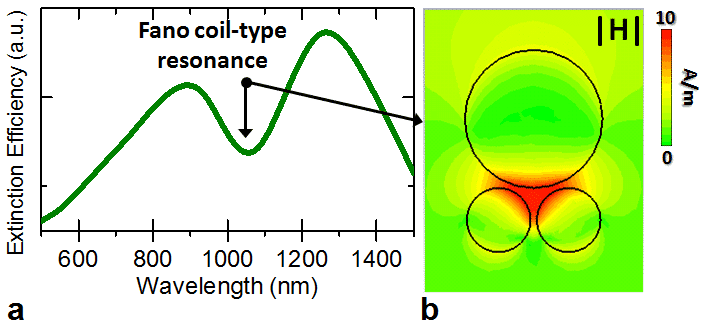
Fano Coil-Type Resonance for Magnetic Hot-Spot Generation
The excitation of electric-like plasmonic modes is a concept well established in the nano-plasmonics state-of-the-art [1-4]. The coupling of linearly polarized radiation with dipolar localized surface plasmons (LSPs) is a process strongly promoted in conventional plasmonic nanoantennas [1-4]. Totally different case consists in the excitation of magnetic-like plasmonic resonances.
The possibility to develop nano-architectures with appreciable magnetic response at optical frequencies has been matter of intense study in the last few years [3]. This aim has been strongly hindered by the saturation of the magnetic response of natural materials at high frequencies ( >100 THz). In the present work we proposed and investigated a plasmonic nano-system supporting the hybridization of an electric and magnetic mode in Fano resonance condition (see Fig.1).
In detail, we were able to induce a “Fano coil-type” resonance in a planar disk trimer nano-assembly for the generation of intense magnetic hot-spots. Applying a morphological symmetry breaking to the system (i.e. increasing the size of the upper disk as illustrated in Fig. 1b), we could switch from an electric to a magnetic mode by exploiting de-phasing effects between the supported Plasmon resonances.
Although the spectral range considered is strongly affected by ohmic dissipation, we could induce an intense magnetic hot-spot taking advantage of the Fano resonance condition (see Fig. 1a). Such results are particularly remarkable considering that we conducted our study by employing an exciting radiation orthogonal to the substrate and therefore without external magnetic component aligned to the trimer magnetic momentum.
Therefore, the proposed architectures can offer a new and unconventional way for the generation of intense and localized hot-spots of magnetic nature, thus representing a step further in the optical triggering of spintronic devices.

References
[1] F. Neubrech, et al. ACS Nano, 6, 7326 (2012).
[2] S. Panaro, et al. ACS Photonics, 1, 310 (2014).
[3] C. Huck, et al. ACS Nano, 8, 4908 (2014).
[4] F. De Angelis, et al. Nano Lett., 13 3553 (2013).
[5] A. Nazir, et al. Nano Lett., 14, 3166 (2014).
francesco.deangelis@iit.it
Powered by Eventact EMS